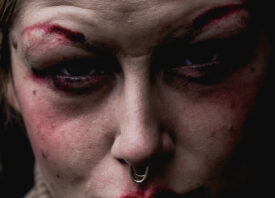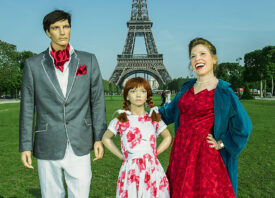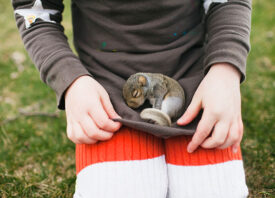Search this site
Meet Suzanne Gloria Lyall, A Girl that Disappeared 18 Years Ago

Suzanne Gloria Lyall

Suzanne’s handwriting
Suzanne Gloria Lyall has been missing since March 2 1998. Then nineteen years old, she was employed on a part-time basis at “Babbages Software” in the Crossgate Malle in Guilderland, New York state. She left work at approximately 9.20pm that day and boarded a bus near the mall. She exited the bus at the Collins Circle stop on the State University of New York (SUNY) campus at approximately 9.45pm, and that was the last time Suzanne was ever seen. When Lausanne-based photographer Virginie Rebetez first met the missing girl’s parents in 2014, something clicked into place emotionally; she knew that she had to create a portrait of Suzanne, bringing together whatever lasting traces she could find. In creating the photo book Out of the Blue, the photographer hopes both to circulate Suzanne’s story in the art world, and gain a better understanding of our intrinsically human need for materiality or physicality in order to gain closure.
Fully immersing herself in the case and the family’s ongoing search, Virginie brought together photographic and textual sources with the objective of presenting another angle to the story using photography as the medium. These included: family archives, images of the first US police helicopter search, Suzanne’s belongings, landscapes, portraits, altered archives and different correspondences between the family in the form of or emails, fax, letters, sketches, maps, the police and several psychics involved in the case. The resulting photo book Out of the Blue “plays with the notion of visible and off-camera” emphasises Virginie, “the idea of touch, repetition, endlessness and materiality is also very present in the book”.

Belongings
How long did you spend working on this story?
“I started this project when I was doing an artist residency in New York in 2014; I have been working on it ever since.”
What first brought the case of Suzanne Gloria Lyall to your attention and why did you feel compelled to tell her story?
“When I decided to work on stories of missing persons, I started to make a selection of different missing persons cases based on the location and the number of years of disappearance; I wanted to meet the families so I sought locations doable by car inside the NY State. It was also very important for me that the case had been open for more than 10 years as I didn’t want to meet a family just after the disappearance of their kids; it was important that some time had passed.
The first family I contacted was the Lyalls. Since the disappearance of their daughter in 1998, Mary and Doug Lyall never stopped looking for Suzanne and for answers. They are really amazing people! Unfortunately, Suzanne’s father passed away last year. In 2001, they created “The Center for Hope”, where they provide assistance to others with similar loss. They connect people while working closely with the police and various missing people related organizations. So, given that they are very active in the search for their daughter and involved in several organizations helping the families of missing kids, they are used to speaking about their story and open to sharing their feelings.
When we met for the first time in 2014, I knew straight away that I wanted to work on Suzanne’s story. Something clicked…and I just followed this gut feeling… We got along very well and the material related to the 18 years investigation was incredible.”

Doug Lyall
Did you already have a preconceived idea regarding the narrative angle?
“I wanted to communicate that feeling of time freezing that families of missing people experience and their endless search for closure.”
Did you feel personally involved in the family’s drama and desire for closure as you worked on this project?
“Of course! I think it’s a really really difficult situation to have a loved one vanishing and not knowing what happened to him or her. The questions and scenarios are endless… After working on Out of the blue for 2 years, Suzanne is really part of my life too now. She has been next to me daily and sometimes she is even in my dreams. And it is not just me thinking about her, she is also present in my friends’ and co-workers’ minds, those who followed the project since the beginning and regularly asked questions about her and the investigation progress. I really love that she took a place in many new peoples’ minds.”

Suzanne Gloria Lyall
Do you feel as though you know more about Suzanne’s identity after having worked Out of the Blue?
“Definitely. Throughout my visits to the Lyall’s family home, I talked a lot with Suzanne’s parents about her, about her personality, her passions, her daily life. I started to build a lot more details around the initial portrait of her I knew from the internet, creating a more complex portrait. But I never met her, so I still only have a tiny window onto her identity.
During the days I spent with the Lyalls family, I saw many family pictures, objects and clothes cherished by Suzanne, poems she was writing, music she was listening to, places she liked to hang out and so on. Of course, in such an intimate situation, you start to feel close to the person. For the “age-progressed composites” (present in the book) that I made in collaboration with a US forensic artist, I had to give him an idea of Suzanne’s taste in clothes and aesthetics, in order to choose the clothes, the haircut, the jewellery and the color atmosphere of the portrait.”


Photocopy of Suzanne, used for the cover of Out of the Blue.
Has any progress been made by forensic detectives or is this case still unresolved?
“The case is still open and will remain open until they find answers. About a month ago, a search was carried out in the Mohawk River using new technology. A company offered their help and their state of the art high tech tools to scan the river. It will take some time to know the results of the data collected there.”

Hudson River Area
All of your projects have in common the theme of missing or unidentified people, why do you feel so drawn to stories of this nature?
“While this is the first time that I am actually working on a project related to missing people, I’ve been reading and researching about this for years while simultaneously exploring unidentified people cases. Indeed, I made a project in 2009 in Los Angeles about unidentified people, called Visiting Jane; based on the information found on police websites describing physical characteristics and giving locations details (in order to give them an identity) I started a substantial work on Google maps to find the exact locations where the body was found and photographed myself in these old crime scenes. The same physical characteristics data from the Police websites concerning Los Angeles County. Unidentified people were then combined and re-organized in poetry-form, creating new portraits, in my project Casting Jane, realized afterwards.
In all my projects I’m interested in the invisible, in traces left after a death or an absence, in the space created by loss, in unfinished or unresolved stories. When a person dies or is missing, this absence leaves a space. All my work is about that space; I try to understand and immerse myself into that territory. I’m fascinated by our need, as humans, of materiality or physicality, in order to get closure, to be able to “finish a chapter”. I can say, in a way, that I use Photography to give materiality to this empty space created by absence; trying to give a form, a shape, to what is not there anymore.”
What do you hope will come out of this project and what’s next?
“Well, an interesting point is that the story of Suzanne will enter a new area of circulation; it won’t be in the police or the press field anymore, but will enter a new field, the art world. So it will bring a new circulation of the story, and because of the distribution of the book, it can bring new discussions.
I really wish for Suzanne’s family to find the answers they need. I don’t have the pretension of thinking that my book will bring them these, but if it can help them in any ways, I would be very happy.
What’s next? I am busy now, with the publisher (Delphine Bedel from Metas/Books) and the graphic designer (Christof Nuessli) finishing the editing. The book will be out in October and then will follow some launches and shows in different cities during various Photography events, in the fall. Then, at the end of the year, I will start a residency in Cairo, Egypt for a new project.”

All images © Virginie Rebetez



